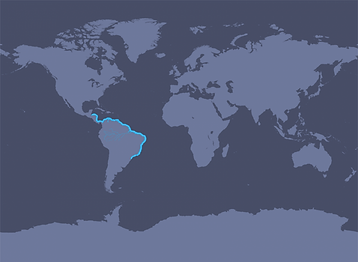
dolphins whales community
TUCUXI
Sotalia fluviatilis
Classification:
The two 'populations' have recently been formally recognised as separate species; S. fluviatalis, otherwise known as the tucuxi, is a freshwater species whilst S. guianensis is marine, and now known as the Guiana dolphin.
Appearance:
Individuals in the genus Sotalia are similar in overall appearance to the bottlenose dolphin although they are smaller, have a low triangular dorsal fin, broad flippers, and a narrow more pronounced beak.
Colouration ranges from blue to grey with a lighter underside of white, grey, or pink.
The tucuxi is generally smaller than the Guiana dolphin with individuals in the coastal populations up to 30% larger, although where their range overlaps
Behaviour:
Tucuxi are usually found in small groups of only a few individuals although they can also be seen in larger groups.
They are extremely sociable and perform impressive acrobatics, including spyhopping, lobtailing, flipper slapping, and porpoising.
They are, however, not known to bow-ride, are shy and difficult to approach. They make short dives, usually lasting 30 seconds to one minute.
Tucuxi can often be found in mixed groups with boto, and as the only other cetacean species sharing the same habitat.
Other names:
-
Tucuxi
-
Sotalia
-
Gray dolphin
1.
Maximum length:
-
Male: 1.5m
-
Female: 1.5m
-
Calf: 0.7m
2.
Maximum weight:
-
Male: Unknown
-
Female: 53 kg
-
Calf: Unknown
3.
Diet:
-
Fish
4.
Estimated population:
Unknown
5.
Distribution map:

Distribution:
Tucuxi are known to be distributed throughout the Amazon basin and possibly also in the Orinoco River. Threats to this species include direct kills – because of perceived competition and traditional medicine use, although interestingly they are also protected in many parts of their range because of myth and legend - pollution, accidental bycatch and entanglement in fishing gear, human disturbance, habitat deterioration and fragmentation of populations by dam construction.